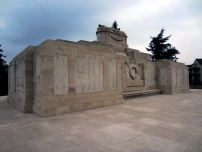| First Name: | Walter | Last Name: | COTTON | |
|---|---|---|---|---|
| Date of Death: | 14/09/1914 | Lived/Born In: | Streatham | |
| Rank: | Rifleman | Unit: | King's Royal Rifle Corps2 | |
| Memorial Site: | 1. Tooting, St Nicholas 2. La Ferte-sous-Jouarre Memorial | |||
Current Information:
Age-23 120, Eardley Road, Streatham
The Battle of the Aisne 13-28 September, 1914 After the Germans were defeated on the Marne they fell back to the River Aisne, closely pursued by both the British and the French. The new German line was a very formidable defensive position. To attack it meant having to cross the Aisne and then climb up a 500 foot high ridge on top of which was the Chemin des Dames, a road that gave the Germans an easy way to move troops along the top of the hills. On 13th September the Aisne was crossed by both British and French troops but after that progress became slower, until there was no progress at all. Both sides dug in and the fighting settled down into trench warfare. The fighting on the Aisne continued for two weeks at the end of which both sides realised that frontal attacks on entrenched positions were both costly and non-productive, not that this deterred them from continuing with this tactic throughout the war. At 3am on 14th September, 2 Brigade of 1st Division and two batteries of artillery moved off to capture the top of the Chemin des Dames ridge from Cerny to Courtecon. The 2nd King’s Royal Rifle Corps battalion led the way, followed by 2nd Sussex. When the leading company of 2nd King’s Royal Rifle Corps reached the top two hours later, they surprised a small enemy forward post but as they were unable to progress any further, two more companies were sent up. By now there was heavy rifle fire from both sides, a roar in fact but no artillery fire. There was obviously a strong German presence in front of them. At 6.30am 2nd Sussex moved up and deployed on the left of 2nd King’s Royal Rifle Corps. Each battalion held about 800 yards of front. 1st Loyal North Lancashire then also came up from Brigade reserve to support another attack; this time on a Sugar Factory just beyond the ridge. All three battalions advanced and after occupying the buildings they entrenched on the ridge beyond. They could go no further but German counter attacks were equally fruitless. Fighting surged to and fro all day and there were of course many casualties, one of whom was Walter Cotton. |
||||
| « Back to Search Results | ||||
| If you think any of the information shown here is incorrect, Click Here to submit your amends and comments | ||||




